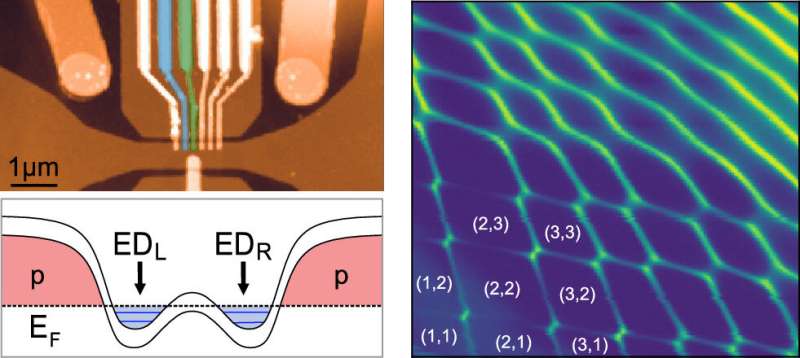March 11, 2020 feature
Bilayer graphene double quantum dots tune in for single-electron control

The first demonstration of graphene double quantum dots in which it is possible to control the number of electrons down to zero has been reported in Nano Letters. Far from an abstract academic stunt, the results could prove key to future implementations of quantum computing based on graphene. "Having exact information and control over the number of electrons in the dots is essential for spin based quantum information technology," says Luca Banszerus, a researcher at RWTH Aachen University in Germany and the first author of the paper reporting these results.
Although this level of control has been demonstrated in single quantum dots, this is the first demonstration in graphene double quantum dots, which are particularly useful as spin qubits. "Using a double dot heavily facilitates the readout of the electron's spin state and the implementation of quantum gates," Banszerus adds.
Less edgy quantum dots
The idea of using graphene in quantum dots dates back almost as far as the first reports of the material's isolation in 2004. Graphene has almost no spin-orbit interaction and very little hyperfine coupling, which would suggest that spin lifetimes can be extremely high. Unfortunately, quantum dots physically etched from larger graphene flakes run into problems due to the disorder at the dot's edges disrupting the material's behavior. As a result, the transport behavior of these quantum dots is dominated by localized states at the edges. "This leads to an unknown effective quantum dot size and an occupation of typically many electrons," says Banszerus.
Instead, Banszerus and colleagues at RWTH Aachen and the National Institute of Materials Science in Japan work with bilayer graphene, which can be tuned to be a semiconductor. A voltage applied to specific regions of a bilayer graphene flake can switch those regions to behave as insulators, electrostatically defining a quantum dot that has no edge states nearby.
The Aachen researchers strip single flakes of bilayer graphene from graphite (mechanical exfoliation) and handle it using a dry pick-up technique that hinges on van der Waals interactions. They encapsulate the bilayer graphene in hexagonal boron nitride (hBN) crystal. They then place the structure on a graphite flake, which acts as the bottom electrode, and add chromium and gold split gates and finger gates separated from the split gates by a 30-nm-thick layer of atomic layer deposited Al2O3.
They were able to control the number of electrons on the quantum dots by applying a voltage, which also affected the tunneling coupling between the dots. As a result, once the total occupation of the two quantum dots exceeds eight electrons, they begin to behave as one single quantum dot, rather than a double quantum dot. Transport measurements also revealed that the number of electrons loaded on the quantum dot could be controlled down to zero electrons.
The idea of defining quantum dots in bilayer graphene electrostatically in this way is not new. However, although different groups have attempted this approach since 2010, the process required recently discovered tricks of the trade, such as better encapsulation in hBN and the use of graphite flakes as gates to get a clean band gap. Banszerus says these developments came as quite a surprise and revived interest in graphene quantum dots in 2018. He hopes the capabilities they have now demonstrated will further spark activity in this field.
Coupling control
"Even though being able to control the number of charges in a graphene double dot is a huge step forward, there are still many problems to be solved on the road toward spin-based quantum information technology in graphene," says Banszerus. Next, he hopes to tackle the problem of controlling the coupling between the quantum dots and the reservoir, which he hopes to achieve by adding an additional layer of interdigitated finger gates on top.
More information: Luca Banszerus et al. Single-electron double quantum dots in bilayer graphene, ACS Nano 2020. DOI: 10.1021/acs.nanolett.9b05295
Journal information: Nano Letters , ACS Nano
© 2020 Science X Network




















